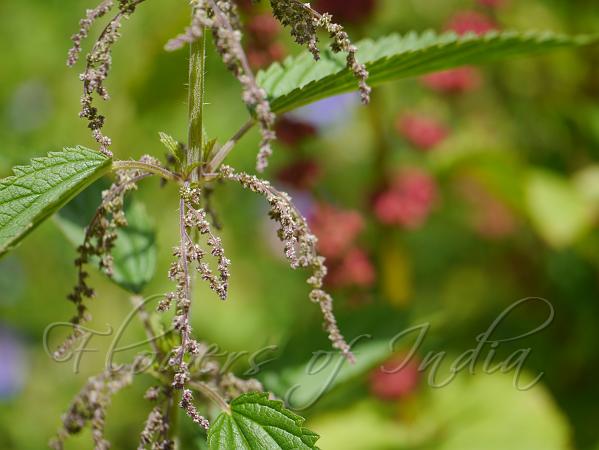|
| Stinging Nettle |
|

|

| File size | 6898944 |
| Original date | 8/2/12 10:11 AM |
| Resolution | 4592 x 3448 |
| Flash | Flash did not fire, auto |
| Focal length | 45.0mm |
| Exposure time | 1/1000s |
| Aperture | 3.2 |
| Focus Distance | |
| Metering Mode | Multi-segment |
| Camera make | Panasonic |
| Camera model | DMC-G3 |
| Sensor type | OneChipColorArea |
|
|
|
|
Photo: |
Botanical name: Urtica dioica Family: Urticaceae (Nettle family)
Stinging nettle is a very interesting plant. It looks like an ordinary,
hairy weed with attractive little flowers, until touches it with bare
hands. It gives a terrible sting, which is very painful. It is a perennial
herb, 3-7 ft tall, dying down to the ground in winter. It has widely
spreading rhizomes and stolons, which are bright yellow as are the roots.
The soft green leaves are 3-15 cm long and are borne oppositely on an
erect wiry green stem. The leaves have a strongly serrated margin, a
heart-shaped base and a long-pointed tip with a terminal leaf tooth longer than
adjacent laterals. Each leaf has a pair of elliptic stipules at the base.
This is a distinguishing feature of the plant.
It bears small greenish or brownish numerous flowers in
dense clusters in leaf axils. The leaves and stems are very hairy with
non-stinging hairs and also bear many stinging hairs, whose tips come off
when touched, transforming the hair into a needle that will inject several
chemicals: acetylcholine, histamine, 5-HT or serotonin, and possibly
formic acid. This mixture of chemical compounds cause a painful sting. The
pain and itching from a nettle sting can last from only a few minutes to
as long as a week. In India, Stinging Nettle is found in the Himalayas,
from Pakistan to SW China, at altitudes of 1000-2500 m.
Flowering: August-September.
| Identification credit: Gurcharan Singh | Photographed in Valley of Flowers, Uttarakhand. |
• Is this flower misidentified? If yes,